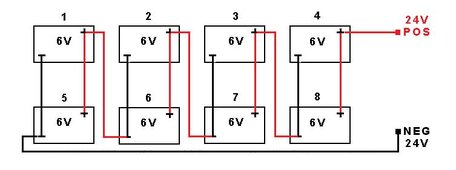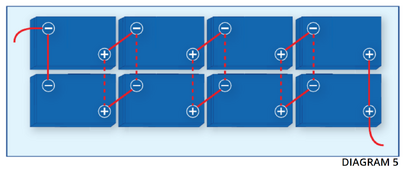Harold2940
New Member
Greetings.
This is just a general battery question. A friend of mine purchased four 6-volt golf cart batteries and wired them in series to run a 24V inverter. This is just for emergency backup power, and he will be charging them via a charger plugged into the grid.
Here's what he has now:

He is planning to purchase four more and connect them in parallel for double the capacity. He asked me how he should wire them, so I told him, like this:

Create another 24V serial string, and connect the two strings together in parallel. This is what I would call Series/parallel.
I worked for "Ma Bell" for over forty years, and was very familiar with central office power. We used twenty-four 2V lead-acid cells wired together to produce 48V battery strings. We had several (sometimes 5 or 6) 48V series strings connected in parallel to create a massive 48V power plant that could run the entire central office for a minimum of eight hours. In the case of a commercial power loss, the backup generator would usually auto start within seconds. The generator was always engineered to carry the full load of the office and keep the batteries charged. The eight hour window was for a real emergency situation where commercial power was lost, AND the generator failed to start. We had eight hours of battery time to either get the generator running, or bring in a portable generator.
All of our individual 48v strings of batteries were not connected together with wire. We used solid copper bars to interconnect the batteries and chargers.
Getting back to my friend's question, there is another way to connect them together, which is what I would call Parallel/series:

In this case, each 6V battery is connected in parallel with another, and the four 6V paralleled batteries are then wired in series. I have never seen this done, and in all the years of my time with Ma Bell, I've never seen her do it either. Other than considerable more interconnecting wire being more expensive, what are the ramifications of series/parallel vs parallel/series?
Thanks!
This is just a general battery question. A friend of mine purchased four 6-volt golf cart batteries and wired them in series to run a 24V inverter. This is just for emergency backup power, and he will be charging them via a charger plugged into the grid.
Here's what he has now:

He is planning to purchase four more and connect them in parallel for double the capacity. He asked me how he should wire them, so I told him, like this:

Create another 24V serial string, and connect the two strings together in parallel. This is what I would call Series/parallel.
I worked for "Ma Bell" for over forty years, and was very familiar with central office power. We used twenty-four 2V lead-acid cells wired together to produce 48V battery strings. We had several (sometimes 5 or 6) 48V series strings connected in parallel to create a massive 48V power plant that could run the entire central office for a minimum of eight hours. In the case of a commercial power loss, the backup generator would usually auto start within seconds. The generator was always engineered to carry the full load of the office and keep the batteries charged. The eight hour window was for a real emergency situation where commercial power was lost, AND the generator failed to start. We had eight hours of battery time to either get the generator running, or bring in a portable generator.
All of our individual 48v strings of batteries were not connected together with wire. We used solid copper bars to interconnect the batteries and chargers.
Getting back to my friend's question, there is another way to connect them together, which is what I would call Parallel/series:

In this case, each 6V battery is connected in parallel with another, and the four 6V paralleled batteries are then wired in series. I have never seen this done, and in all the years of my time with Ma Bell, I've never seen her do it either. Other than considerable more interconnecting wire being more expensive, what are the ramifications of series/parallel vs parallel/series?
Thanks!



